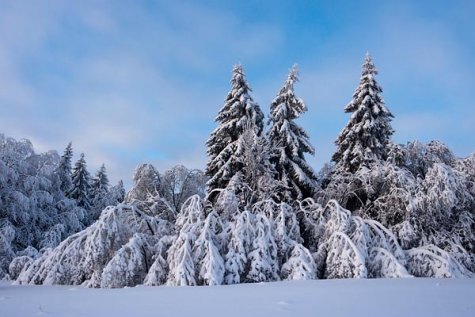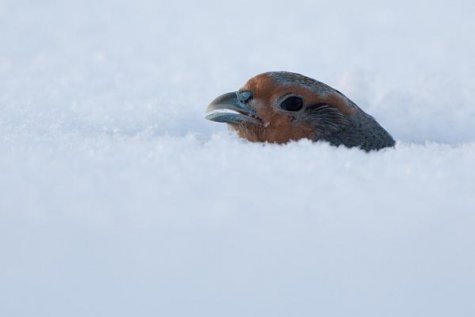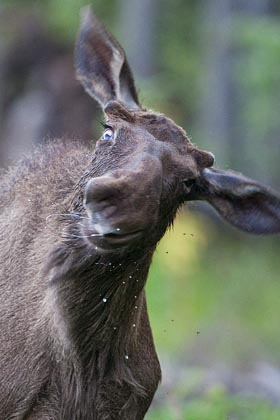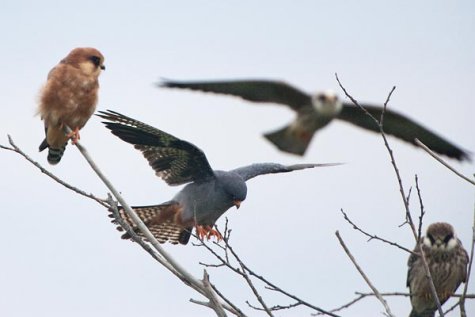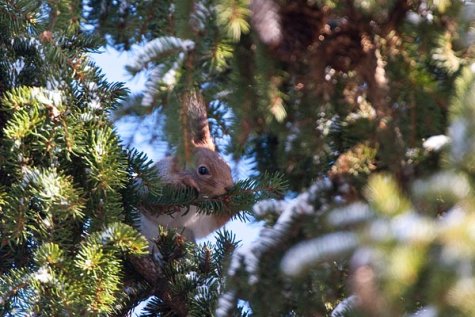From Kristel Vilbaste's weekly chronicles - a summary of the year in nature in Estonia 2010
Text: Kristel Vilbaste
Photos: Arne Ader
Translation: Liis
Originally published December 29, 2010
Title: Last week of December: wolves howling at the moon
Deluge of snow in Haanja on January 9, 2010. The load of snow has pressed the tree tops to the ground.
“Swoosh“, and a shovel-load, “swoosh“ and again a shovel-load! Ten times running, then a breathing space. While I was reducing the snowdrifts, a tiny shrew suddenly appeared beside the shovel – tried to bore its way first through one snowdrift, then another, finally I took it to the woodshed a metre away.
The four winter signs of the week
wolves howling at night,
the red bullfinch globes in the lilac,
yellowish water on the pond ice
and
whirling blizzard!
January
The year started with a snow cover more than half a metre deep in nearly all Estonia, snowdrifts were metre-high in places. The snow was thick and fluffy, both skis and animals’ feet sank through it. The frost got going in the third week, forcing the thermometer column to 36 degrees below zero near Palamuse. The Gulf of Finland froze. But the tits started calling for „teacher, teacher“ (or their Estonian „sitsikleit“, summer dress).
Partridge in snowdrift
February
The month of collapsing roofs; house roofs caved in at Väike-Maarja and elsewhere in Estonia too. People stayed on the roofs – in places meter-deep snow had to be shovelled down. The snowdrifts around houses reached to the eaves, window openings had to be cut out in the snow. The swimming venture of the young elk with a happy ending in view of the seal camera; deer started to die in the forests. At the end of February there were already raven displays, and the waxwings returned.
March
The first thaw of the year arrived, the snowdrifts humped down. In Võrumaa that only had 30 centimetres of snow the first green growths appeared at house walls. In the Tallinn area swans died as if mowed by scythe. In the second week of March starlings, larks, cranes and others already arrived from the south. Web camera eagle Linda laid two eggs. In the last week of March tortoiseshell buttterflies delighted us with their bright colours.
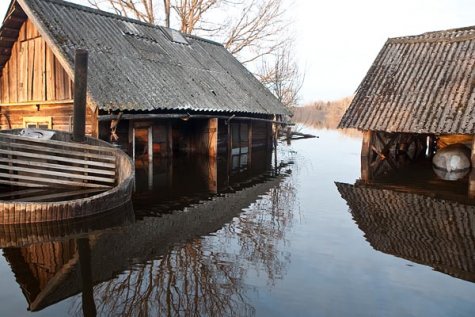
Flood at Soomaa on April 8, 2010. During the first week of April river Raudna rose above the blue line on the Karukose sauna wall, marking the highest water level in the 1956 flood.
April
In the first week liverwort (Hepatica) buds opened, and the birch sap was unbelievably sweet this year. Waters overflowed, villages in low fields drowned. In Soomaa a guessing game went on about when the water level would go above the previous record. The new record height came on April 6 – 4 meters 94 centimetres. Lake Peipus rose up to the hundred-year old dune bank, the ice took all shore reeds with it. Frogs, in numbers such as never before.
May
In the second week of May thunder clapped and all migrant birds arrived at once. At the end of May the weather turned so hot that we could go swimming in Lake Peipus. But then the mosquitoes arrived, and not merely mosquitoes but pure mosquito hell. Bird cherries flowered at the same time as the sticky catchfly and cow parsley, apple trees before plum trees in places – the time reckoning of plants was quite awry.
Mosquitoes attacking elk
June
In the beginning of June city champignons appeared, at the end of the month russulas and the rufous milk cap. The Midsummer flower display was midsummer bright already a week before Midsummer. A surfeit of wild strawberries. It was rainy and somewhat cool. Towards the end of the month a heat wave arrived, mosquitoes handed over to horseflies and gnats. The first wave of blue-green algae in Lake Peipus.
July
A whole month of beach weather, the sun-heated water near the shore was almost 30 degrees. Fish began to die in Lake Peipus. Sun, sun, sun - and then thunder. At the end of the month the thunderstorms felled forests clean, at Lake Peipus trees went down as if scythed. The hot weather swelled melons and water melons, tomatoes and cucumbers, raspberries and strawberries – there was everything in plenty.
In August, when forest fires spread in Russia, an invasion of redfooted falcons was noted in Estonia
August
In the beginning of the month the roofs and glasshouses that had remained standing under the weight of snow flew off. In one squall the church tower of Väike-Maarja landed on the roof of the chapel. Courtyard trees and sparse forest stands were thrashed. Swimming water suddenly went unexpectedly chilly. Birds set off on their migration early.
September
An immense overflow of mushrooms, there was nobody who didn’t find mushrooms in the forest. A dearth of apples in southern Estonia, a surfeit in eastern Estonia. Acorns bigger than ever before and large crane flocks. Much red in nature. The chirruping of crickets ended with the last week of September.
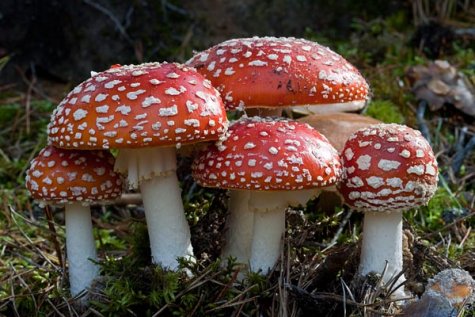
October
Frosty mornings began in the second week of October, the first snow fell in the third week – on unfrozen ground. Whooper swans had a large offspring, many „ugly ducklings“ were to be seen in the migration. Storm winds again felled trees.
November
In the beginning of the month plants made an attempt to flower once more, the snow had not yet harmed the nettles. Until Mardipäev, St Martin’s Day, mosquitoes, flies, night moths and bats were still out. At the end of the month storm winds again, and snow fell.
There were few cones. Squirrels ate spruce buds
December
Snow, snow, snow. The snowdrifts quickly reached up to the windows. In the beginning of the month thunder crashed on the northern coast in the middle of a blizzard. In the second week the snowstorm of the century arrived, 600 people were caught in the snow for 24 hours in Padaorg. At the end of the month meter-high snowdrifts. Roof shovelling began, glasshouses collapsed. There were no thaws.
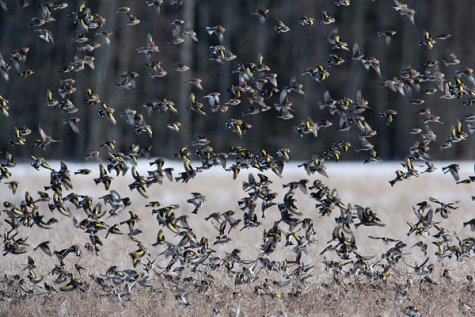
Near lake Võrtsjärv bird enthusiasts noted a record-sized goldfinch flock. In the photo goldfinches and linnets
What was special in your 2010 nature year:
Mikk Sarv: After 19 years the winter solstice again coincided with a full moon, good times are returning for Estonia.
Gennadi Skromnov:Two winters this year. January and February without a single day of thaw and an astonishing number of days with rime. A month of winter with snow and thunder. The snow lights drove off the depressing autumn darkness, the kaamos.
Agu Leivits: Insouth-eastern Estonia the star event was surely the mighty springtime flood in Soomaa! But there was plenty of heat and cold as well as water – I think that for the bogs this was a good year, the hot summer notwithstanding, their water balance is on the plus side!
Kaja Kübar:The roe deer had a difficult year in the beginning as well as the end, roughly a third of the population perished. Owls learnt to hunt mice at waste bins in cities.
Urmas Tartes:Certainly the overflow of mushrooms, even my old friend the Taevakoda shaggy pholiota again grew a nice set of caps after some years. And surely the general great meltwater that flooded even the smallest hollows, so that eggs of forest mosquitoes, having lain in wait for years, began developing and the spring and summer delighted us with an extraordinary mosquito season. Later the mosquito abundance receded to within normal limits.
Olev Merivee: Seen as a mushroomer– never have I picked such basketfuls heaped with boletes ... didn’t bother to pick the large ones, we were only interested in the tiny thumbs!!!
Arne Ader: The shortage of cones was so bad that squirrels fed on spruce buds and shoots. In summer an enormous flock of goldfinches. And I liked the noble fight to protect the Tuhala Witches Well.
I myself remember the hour-long soaks in 29 degrees warm lake water, for a whole month, every day.
Everything was abundant in nature this year – snow, water, sun, storms, blizzards
* * *
This is Kristel Vilbaste's summary of the year 2010. Her weekly chronicles have appeared for several years in Looduskalender and in Estonian newspapers. Now the stories in Looduskalender are on the German page too.
We are looking for translators from Estonian into English for Kristel Vilbaste’s stories! See in the forum
HERE!

